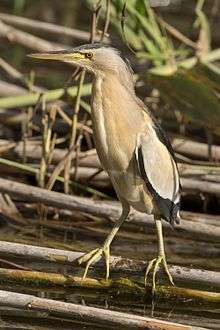Little bittern
| Little bittern | |
|---|---|
 | |
| Little Bittern in Spain/Majorca | |
| Scientific classification | |
| Kingdom: | Animalia |
| Phylum: | Chordata |
| Class: | Aves |
| Order: | Pelecaniformes |
| Family: | Ardeidae |
| Genus: | Ixobrychus |
| Species: | I. minutus |
| Binomial name | |
| Ixobrychus minutus (Linnaeus, 1766) | |
The little bittern or common little bittern (Ixobrychus minutus) is a wading bird in the heron family, Ardeidae. Ixobrychus is from Ancient Greek ixias, a reed-like plant and brukhomai, to bellow, and minutus is Latin for "small".[2]
This bittern is native to the Old World, breeding in Africa, central and southern Europe, western and southern Asia, and Madagascar. Birds from temperate regions in Europe and western Asia are migratory, wintering in Africa and further south in Asia, while those nesting in the tropics are sedentary. It is rare north of its breeding range.[3]
In Britain there were intermittent reports of breeding in the nineteenth century, and again in 1946 and 1957, but none of these records were proven. The first proven British breeding record is from Yorkshire in 1984, and the second from Somerset in 2010.
Description
.jpg)
It is a very small bittern; measuring 25–36 cm (9.8–14.2 in) in length, 40–58 cm (16–23 in) across the wings and weighing 59–150 g (2.1–5.3 oz). It is among the smallest heron species. It has a short neck, longish bill and buff underparts. The male's back and crown are black, and the wings are black with a large white patch on each wing. The female has a browner back and a buff-brown wing patch.
Taxonomy
The three subspecies are:
- I. m. minutus – (Linnaeus, 1766): nominate, found in Europe, Asia, northern Africa; winters in sub-Saharan Africa and southern Asia
- I. m. payesii – (Hartlaub, 1858): found in sub-Saharan Africa, resident
- I. m. podiceps – (Bonaparte, 1855): found in Madagascar, resident
The Australian little bittern (I. dubius) and the extinct New Zealand little bittern (I. novaezelandiae) were formerly considered subspecies of the little bittern.[4]
Status
The little bittern is one of the species to which the Agreement on the Conservation of African-Eurasian Migratory Waterbirds applies.
Behaviour
The little bittern's breeding habitat is reed beds. It nests on platforms of reeds in shrubs, and four to eight eggs are laid. It can be difficult to see, given its skulking lifestyle and reed bed habitat.
These bitterns feed on fish, insects and amphibians.
- Little bittern in the Aldomirovtsi Marsh, Bulgaria
 An adult during ringing in northern Italy
An adult during ringing in northern Italy.jpg) An immature little bittern, camouflaged in its reed bed habitat
An immature little bittern, camouflaged in its reed bed habitat.jpg) An immature little bittern, in the open, but still near the water
An immature little bittern, in the open, but still near the water
References
- ↑ BirdLife International (2014). "Ixobrychus minutus". IUCN Red List of Threatened Species. Version 2014.3. International Union for Conservation of Nature. Retrieved 2 January 2015.
- ↑ Jobling, James A (2010). The Helm Dictionary of Scientific Bird Names. London: Christopher Helm. pp. 208, 256. ISBN 978-1-4081-2501-4.
- ↑ Rasmussen, Pamela C.; Anderton, John C. (2005). Birds of South Asia. The Ripley Guide. ISBN 84-87334-67-9.
- ↑ Christidis, Les; Boles, Walter E. (2008). Systematics and Taxonomy of Australian Birds. CSIRO Publishing. ISBN 978-0-643-06511-6.
- del Hoyo, J.; Elliot, A.; Sargatal, J., eds. (1992). Handbook of the Birds of the World. 1. Barcelona: Lynx Edicions. pp. 425–426. ISBN 84-87334-10-5.
External links
| Wikimedia Commons has media related to Ixobrychus minutus. |
| Wikispecies has information related to: Ixobrychus minutus |
- Ageing and sexing (PDF) by Javier Blasco-Zumeta and Gerd-Michael Heinze
- Little Bittern, The Atlas of Southern African Birds
- BirdLife species factsheet for Ixobrychus minutus
- "Ixobrychus minutus". Avibase.

- "Little bittern media". Internet Bird Collection.
- Little bittern photo gallery at VIREO (Drexel University)
- Interactive range map of Ixobrychus minutus at IUCN Red List maps
- Audio recordings of Little bittern on Xeno-canto.
